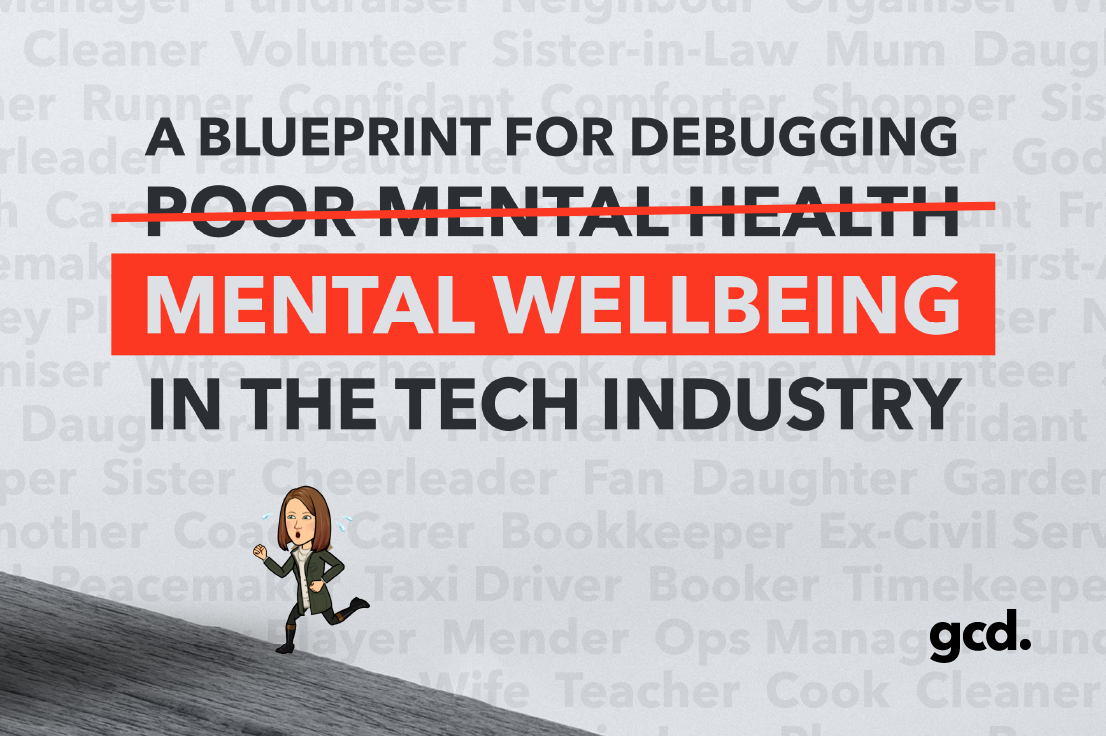My name is Nikki, I’m the Operations Manager here at GCD, but I’m also a mum, wife, daughter, sister, aunt, runner, hockey player and a long list of other things. And I’ve also experienced my own battle with mental health. I was diagnosed with depression in 2017. Mental Health and Mental Wellbeing are extremely important to me which is why I wanted to write this blog.
I’m going to look at debugging mental wellbeing in the tech industry and the steps we can take to learn, grow and empathise together. Let’s get started!
So, what is mental health?
“Mental health is a state of well-being in which the individual realizes his or her own abilities, can cope with the normal stresses of life, can work productively and fruitfully, and is able to make a contribution to his or her community.”
World Health Organisation
The Bug – Poor mental health and Mental illness
Poor mental health is when we find it difficult to manage how we think, feel, act with respect to daily stresses (maybe you have difficulty getting to sleep, trouble concentrating, just don’t want to get out of bed in the morning, or don’t feel like having a chat with someone at lunch).
Poor mental health is common, we all deal with it at some stage. It doesn’t mean someone is mentally ill. However, continuous episodes of poor mental health could indicate something more serious is going on.
BUT It’s not black and white, it’s a spectrum. What we need to remember is that we all have chinks in our armour. We don’t have to have a diagnosis of a mental illness to have poor mental health, so let’s remove the stigma of ‘craziness, insanity and being mental’ and accept that this topic is relevant to everyone.
Mental Wellbeing
From here on, we’ll refer to this ‘bug’ as mental wellbeing. Let’s not box it up as ‘poor mental health’ and present it as a negative phenomenon that only affects a few.
Let’s go with the concept that it’s relevant to us all, and is equally important as physical wellbeing…
The National Institute for Health & Care Excellence states that common mental health disorders affect an estimated 1 in 6 adults at any one time.
And yet, poor mental wellbeing is probably under-reported due to the stigma, and the true impact unknown.
Zoning in further, alarmingly, evidence suggests that the tech industry has a much higher prevalence of poor mental wellbeing (up to 5 times as much) amongst staff than the UK average.
Factors that affect our mental wellbeing
There are many factors that can influence our mental wellbeing:
- Psychological factors
Past events such as trauma, abuse, loss, bullying, loneliness and neglect.
- Biological Factors
Such as genetics, physical health, drug and alcohol misuse, and brain chemistry.
- Environmental Factors
The weather, air pollution, and our working and living conditions.
How poor mental wellbeing affects the individual
Poor concentration, worry, difficulty with decision making, less interest in day to day things, low mood, feeling overwhelmed, being tearful, having sleep disturbance, tiredness, social avoidance, feeling emotional, being irritable or aggressive.
How does this translate to the workplace?
- Absenteeism
- Work performance
- Relationships at work
Why does it particularly affect the tech sector?
The Nature of the Job
The UK Chief Medical Officer (when he’s not dealing with a pandemic) advises that for good physical and mental wellbeing, adults should aim to be physically active every day, they should aim to minimise the amount of time spent being sedentary, and when physically possible should break up long periods of inactivity with at least light physical activity.
And here lies the problem:
The tech industry by its very nature is a sedentary industry. Generally speaking the job involves long periods of sitting indoors, quite often under artificial lights and with poor ventilation, staring at a screen or multiple screens.
More often than not work in the tech industry is done in isolation, and research has found that 64% of lone workers face psychological distress, which is significantly higher than employees working alongside colleagues.
This is especially relevant during the current pandemic – who has missed the laughter, comradery, support and banter?
The Nature of the Workforce
The demographics of the tech industry is skewed towards younger male workers.
Millennials (usually thought of as those born after 1984) make up a large proportion of the tech industry and much has been written about them. Simon Sinek (Author and TED Speaker) did an interesting talk about Millennials. He stressed that through no fault of their own, Millennials have the trait that if something isn’t great, they move on rather than address the unhappiness.
In addition, people who spend more time on social media (more likely younger generations) have higher rates of depression than those who spend lower amounts of time. They quite often get a hit from how many likes, shares or retweets they’ve generated with a social media post, rather than through the satisfaction of working at something over a period of time and being able to look back at the progress made. This instant hit releases dopamine in the body (known as the ‘feel-good’ neurotransmitter), rather like alcohol and drugs do, and like these substances – they may be okay in measured amounts, but excessive amounts can be extremely dangerous.
Approximately 84% of the tech workforce is male. While mental wellbeing difficulties can affect anyone regardless of demographics, studies have shown that certain mental illnesses affect men and women differently. Perhaps the most interesting (and worrying) finding is that while on average more women are diagnosed with common mental illnesses than men, the rate of male suicide is significantly higher. This suggests that men are suffering with mental distress, but may not be receiving (or indeed asking for) the help they need.
The Nature of the Industry
You’ve probably heard about the Digital Revolution – the UK tech industry is a high growth, fast paced industry, which grew 6 times faster than any other industry in the UK economy in 2018, and has been described as being “right in the driving seat for the future”.
The industry has a reputation of being ‘always on’ – bugs, crashes and hacks can happen at any time of the day or night.
Our work emails and documents are available on our own personal phones, and all of this means that it’s harder to separate our work and private lives.
So how do we fix this? A study recently reported that three-quarters of employees don’t think that their workplace offers enough mental wellbeing support.
This needs to change.
Addressing mental wellbeing is a crucial issue, as it affects individuals in their personal lives as well as at work – this is why the World Health Organisation has dedicated a day as World Mental Health Day – 10th of October.

Employers have a duty of care to all staff. You’ll see the signs for where the fire exits are, who your first aider is, and you’ll know where to find a bandage or plaster. But what provisions are made for mental wellbeing? We need to be proactive about it.
So who’s job is it to fix this bug?
I reckon it’s a top down and a bottom up approach, and that we should be tackling it from the outside in and the inside out.
Starting at the top, mental wellbeing needs to be brought out of the shadows and into the spotlight of the boardroom, so that executives can ensure their employees have access to the resources and support they need.
Companies need to put in place their own policies and training to support employees, as well as raise awareness of mental wellbeing. Simon Sinek, in a separate talk about empathy, stated that “the real job of a leader is NOT to be in charge, but to take care of those in our charge.”
Generally organisations do not, however, have a “Director of Wellness”, so we also need stakeholders – internal champions. Subject matter experts.
However, ultimately, we shouldn’t leave wellbeing up to other people. Personal maintenance is also vital, especially given that mental wellbeing is subjective and a myriad of factors can influence it.
So in essence, we’re all in this together. Each and every one of us.
The Feature Pack – What can we do to help?
The NHS suggests that there are 5 steps to mental wellbeing, so what I want to look at now is how we can use these 5 steps to write good code for looking after mental wellbeing in our workplaces. There is no out of the box solution to this, but here are some wireframes to get things started.
These are my 6 suggestions:
1. Be aware
We must Educate ourselves. Educate our staff. Educate our management. Educate each other. We need to share our stories, bring in the experts, do our research, and have discussions.
2. Be open
It’s imperative that we talk to each other, but also that we listen. We need to know the verbal and non-verbal cues that people give when they’re not tip-top, and we must break down any barriers or stigmas. We need an equal playing field between physical and mental wellbeing, so we need to be brave and talk about it!
We must normalise these conversations.
3. Be active
I’ve already mentioned that physical activity can help support mental wellbeing, so let’s encourage each other in the workplace to do this. Let’s have lunchtime walks, daily step competitions, after work yoga, five aside, or simply a daily stretching ritual. It doesn’t have to be rigorous or onerous, but we need to keep moving to keep well; and quite often people feel safety in numbers when exercising. It’s also easier once a habit is formed, or when everyone else is doing it.
4. Be nourished
Firstly we must nourish our body: it’s easy to snack on unhealthy products, skip meals, and to overdo the caffeinated drinks at work. If workplaces have tasty healthy alternatives available then perhaps we can change our habits. We can also encourage each other with this.
Then we need to nourish your brains! Keeping our minds active and learning new skills – these steps all add to an overall sense of wellbeing.
And finally make sure you get enough kip because sleep makes a world of difference!
5. Be flexible
We need to listen to individual needs and understand the back stories. A one size approach to promote wellness will not fit all, and a rigid policy will not address the needs of everyone or indeed anyone.
We also need to be flexible in our approach to ourselves and others – we must do what we can to understand and ensure that everyone has a good work-life balance. We must ensure that we come to work feeling well, but also go home feeling well.
6. Be kind
We should be kind to each other inside and outside of the organisation. Social connectedness is known to improve mental wellbeing for all involved. Let’s understand ourselves and understand each other. Forget the “How was your weekend?” chit chat, and dig a little deeper – after all, there are few other people in the world who you spend as much time with (the average person spends ¼ of their adult life at work, or 3,507 days).
Let’s also stretch that kindness beyond the office walls. Why don’t we volunteer, give, help, support – let’s make sure that everyone has the opportunity to do these things. For example, the Stephen Clements Foundation is promoting a Random Act of Kindness Week in December. Why not give it a go?
Conclusion
Overall, however, let’s embed all of these actions and make them part of the culture and the backend of our businesses. We need to ensure that our corporate environments provide everyone with the tools that they need to strike the right balance for mental wellbeing.
It shouldn’t be something that we need to plan and timetable. It should be part of who we are and what we do.
We need to move to a society where all of us become aware of our own mental wellbeing, other people’s mental wellbeing and how to cope with our own and other people’s mental wellbeing when it fluctuates. It is all of our responsibilities to make this change.
This is our call to action.


